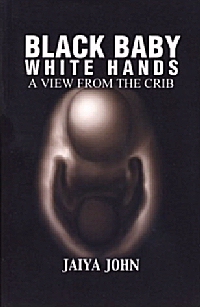
Black Baby White Hands:
A View From the Crib
by Jaiya John
Soul Water Publishing, 2002
Reviewed by Barbara Free
Meanwhile, his birth mother was living as close as Albuquerque. The story unfolds as he grows up, leaves home, confronts his inner demons and his family, and eventually finds a degree of healing as he also finds the various branches of his birth family. It is an amazing story, sometimes very dramatic, even melodramatic, with the emotional intensity that most of us can remember from our own adolescent angst. The author has some wonderful memories of his childhood, as well as the darker ones of feeling alien in the white world of Los Alamos and of his adoptive family, including extended family in Illinois.
Although not mentioned by name in the book, our own Sally File played an important role in the author s life. As you read the story, you will guess some of that role. The book is just out, and has been ordered for the O.I. lending library. It should be required reading for anyone contemplating any kind of transracial or transcultural adoption, just to aid in understanding some of what the adoptee might experience, and to help adoptive parents avoid some of the pitfalls the author’s adoptive parents had no way of anticipating. When the author was adopted in 1968, there were no guidelines, no support groups, no books his family could turn to. It is difficult from the perspective of 2002 to imagine how different society was then. There was no celebration of African American heritage, no African dance lessons, no bumper stickers proclaiming “Celebrate Diversity,” with myriad meanings. His parents were blazing a trail, with no intention of doing so.
We recommend this book to all triad members, but perhaps especially to multi-cultural families of any description.
Excerpted from the October 2002 edition of the Operation Identity Newsletter
© 2002 Operation Identity